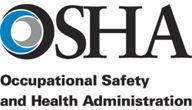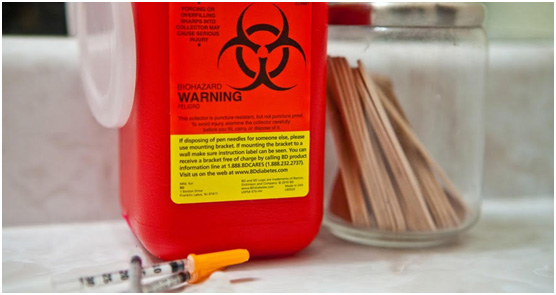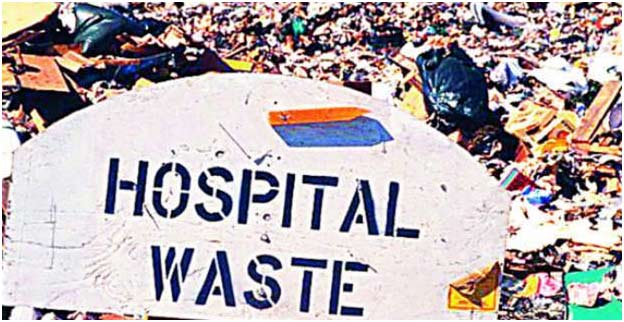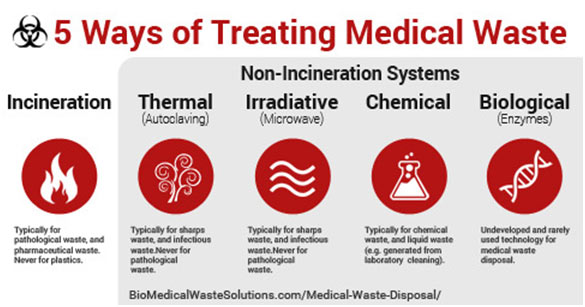100% Compliance & Certified
 |
 |
 |
Making Your Decision as Easy as 1-2-3

ComplianceCompliance with City of Houston, State of Texas and Federal laws governing the disposal of medical waste and red bag waste is the law. We 100% adhere to it. |

Affordable PricingIt is possible to obtain a Biohazard Waste Pick Up Service Provider at affordable rates. Are you saving costs currently? |

ReliabilityWe pay special attention to customer scheduling to ensure your facility gets the attention and customer service it deserves. |
Our Medical Waste Removal Clients Include
 Hospital Biomedical Waste Disposal |
 Dental/Dentistry Waste Disposal Management |
 Dialysis Waste Disposal Management |
 Laboratory Waste Disposal |
 Nursing Homes Disposal Management |
Medical Waste Collection Scheduling
 Daily |
 Weekly |
 Bi -Weekly |
 Monthly |
 Quarterly |
 PRN “As Needed” |
Complete Biohazardous Waste Management Solution
|
|
|
|
|
|
|
|
Our Houston Medical Waste Disposal Services
Are Also for Cities Around Houston, Texas:
Bellaire, TX |
Houston Heights, TX |
Request Quote in 10 Seconds!
* Required information for an accurate quote. 1-877-974-1300.

"Excellent service and we never have to worry about compliance issues."
-Dr. Young, Texas Health Center
Houston Medical Waste Disposal – The Definitive Guide
By Dr. Intan Airlina | Updated: June 2015

Medical waste and its particular proper disposal remain an essential concern for America. Here are the leading reasons:
- The safety of healthcare affected individuals and personnel, and also the legal obligation within handling the waste materials
- Environmentalists are related to the impact connected with medical waste, whether it’s wasting on a beach within Jersey Shore or perhaps being illegally left in landfill sites
- Home producers connected with medical waste, including needles and syringes that are looking to dispose of the tools properly

What Is Medical Waste?
In line with the EPA (Environmental Protection Agency), the definition associated with medical waste is fairly broad “all waste materials generated at health care facilities, such as hospitals, clinics, physician’s workplaces, dental practices, blood vessels banks, and vet hospitals/clinics, as well as medical research facilities and laboratories.” It does not include any business that produces medical waste like syringes or needles off their employees or shoppers, or the home producer as an example. 
How Much Medical Waste Is Produced?
Throughout 2012, the United States spent up to $2.5 billion for the proper disposal of medical waste. Moreover, with annual progress of 4.8%, by 2017 this annual market is likely to increase by $3.2 billion. For instance, look at these medical waste statistics:
- Just hospitals in the U.S. produce a lot more than 5.9 million tons of waste annually
- Hospitals create 33 lbs. of medical waste per day per staffed bed
- Florida alone has approximately 38,000 amenities that generate biomedical waste
In short, nearly all healthcare activities relevant to humans produce healthcare waste. So, are you able to imagine the potential issues of what would likely to happen if it was disposed of incorrectly?
The Epidemiology
(How Often Diseases Occur in Different Groups of People and Why)

WHO (World Health Organization) actually mentioned that in 2000, there were 32% new Hepatitis B infections as a result of improper way associated with contaminated syringe disposal. In 2002, WHO conducted a study to review 22 countries about their method of Houston medical waste disposal management along with resulting various ranges from 18% up to 64% that used improper ways of biomedical waste operations.Dangerous, huh?
Who Are At Risk For Biomedical Waste Exposure?
People who have the highest risk of being the biomedical waste, for instance, healthcare workers, patients, waste collection and disposal staff, and even our environment. The biomedical waste may pose an occupational hazard when managed incorrectly. Therefore, we need special precautions and the well-trained personnel to manage those biomedical wastes and keep the risk low.
Why We Need To Manage The Biomedical Waste In The Right Way?
There are several reasons to manage the biomedical waste in an appropriate way:
- Health – Nobody wants to see blood drops on the floor when they walk into hospital visiting a sick friend because the risk of being infected by any number of diseases
- Infection risk – the risk of infection obtained from sharp injuries can lead to infection
- Environment pollution – The risk of air, water and soil pollution directly from waste due to defective incineration or autoclaving can be harmful.
The biomedical waste treatment and disposal need to be in a complete management to ensure the safety of the workplace and maintain our health. If you maintain the safety process correctly, it will:
- Effectively reduce your legal liability
- Reducing the danger to the community, personnel and patients
- Keep your reputation high
The OSHA (Occupational Safety and Health Administration) has an established procedure for dealing with biomedical waste hazards that can minimize our risk with contaminated articles. Thus, we at BioMedical Waste Solutions, LLC, use OHSA standards as our guidance to dispose the medical waste properly.
Brief History of Regulated Biohazardous Waste Disposal in America:
In 1988, a famous act namely Medical Waste Tracking Act (MWTA) was addressed to handle the disposal of medical waste in coastal areas caused by numerous medical along with household waste during several coastal parts, therefore a two-year software was implemented in the affected areas (New You are able to, New Jersey, Connecticut, Rhode Area, and Puerto Rico). This kind of act was expired in June twenty one, 1991.
During that point, EPA gathered much information and executed medical waste studies and along with MWTA, they managed to see several treatment technologies that has been available in those days involving incinerators, microwave units, and several different types of mechanical and chemical systems you can use for reducing the waste. Thus, resulting a new local regulation of medical waste management that has been implemented to every single state, such as Medical Waste Management 2015, as one of several recent medical waste regulations for California State.
Sorry to be able to disappoint our Walking Dead fans, but improper disposal of medical won’t be the reason for the Zombie Apocalypse in the U.S. because stringent regulations, laws, and guidelines.

Regulated VS Unregulated
Of all the health care waste (HCW) there exists essentially two kinds: Regulated medical waste (RMW) and unregulated medical waste (UMW). Approximately 75% to 90% of HCW can be UMW (unregulated) or often known as healthcare general waste (HCGW). This waste is comparable to typical household waste composed of papers and plastics which might be not been in contact with patients and can be categorized as non-infectious. This waste is simply disposed as per municipal regulations. Roughly only 10% to 25% of HCW can be infectious/regulated medical waste (RMW).
Naturally this RMW should be handled with exclusive care as we’ll describe below because doing so could pose any threat to the healthiness of others, either by contaminating the environment or through direct hitting the ground with an individual. Easier strategy to differentiate the two types is to ask yourself “could this waste kill someone or cause them to become sick?” If yes, then this waste is regulated and need to be handled with exclusive care.
NOTE: The use of “medical waste”will be regarded as “regulated medical waste” (RMW), unless otherwise stated.

Eight Categories of Medical Waste
It’s important to know what kind of medical waste your facility produces then you can determine the proper disposal. The WHO classified the medical waste into eight (8) categories of medical waste:
- Infectious waste – Waste that may transmit infection from virus, bacterial, parasites to human, i.e.: lab cultures, tissues, swabs, equipment and excreta
- Sharps – Sharp waste, such as needle, scalpels, knives, blades, etc.
- Pathological – Human tissue or fluids i.e. body parts, blood, other body fluids
- Radioactive – Unused liquid in radiotherapy or lab research, contaminated glassware, etc.
- Chemical – Expired lab reagents, film developer, disinfectant
- Pharmaceuticals – Expired and contaminated medicines
- Pressurized containers – Gas cylinders and gas cartridges
- General waste (UMW) – No risk to human health because no blood or any related bodily fluid, i.e.: office paper, wrapper, kitchen waste, general sweeping, etc.
Because the management for every waste categories are different.
Stages of Houston medical waste disposal
Where does medical waste go? How is medical waste disposed of? For purposes of this guide, we are going to focus on disposal in the US. Let’s share with you the cautious and special care process in which medical waste is collected, stored, transported and treated with.
Stage 1 – Collecting & Segregating The biomedical waste has to be collected in containers that are resilient and strong from breakage during the handling process. Do not place sharps, used needles, syringes, or other contaminated tools in common waste disposal or recycle bin because the entire waste will be infectious by doing so. The segregation also needs to be performed between the liquid and solid biomedical waste products. Categorizing the medical waste with correct segregation to isolate and manage each waste in the proper way. For this purpose, the segregations come in colored waste containers, label coding and plastic bags.

Stage 2 – Storing & Transporting Unique requirements pertaining to storage services, such as a secure area which is inaccessible to everyone, as effectively as separated from areas pertaining to food consumption. The storage facilities also have to be accompanied with a fridge or freezer unit that can be used with medical waste in the event necessary. Several facilities perhaps provided particular vehicles and protective devices to dispose, handling or perhaps transport this biomedical waste products. Remember to watch and maintain this protective devices periodically so it won’t become a source of transmitting the infections.
Stage 3 – Treatment

The needs of expert handling that work concurring the by-law regulation, for example, the OSHA are expected to guarantee that the controlled regulated medical waste (RMW) is taken care of legitimately. The treatment procedure will utilize a few medicinal waste equipment that ranged from handling, carts, shredding, conveying, size reducing, compactors, to sterilization or recycling. The following equipment is expected to legitimately prepare the waste in order to reduce the hazards, and keep up the environment:
- Carts and containers – regularly used to gather the medical waste i.e. dumpers, compartments, compactors can be utilized to gather the medical waste
- Conveyors – this gear isolate the waste
- Sterilizers – for example, autoclave, shredder, and size redactor
- Handling the waste – for example, compactors, holders, pre-crushers, and deliquefying framework
- Recycling system – i.e. balers and size reduction equipment
Incineration – Type 1 of Medical Waste Treatment The incineration technology used a high temperature thermal process that can convert inert material and gases with the combustion process. It will process the waste to convert into ash, gas, and heat. There are three types of incinerators that are commonly used for biomedical waste:
- The Multiple Hearth Type – it has a circular steel furnace that contains solid refractory hearths with a central rotating shaft to convert the waste into ash
- Rotary Kiln – it is an incinerator, shape like a drum, commonly for medical and hazardous waste
- Controlled Air – there are two process chambers that will handle the waste. The complete combustion and oxidizing it, leading to a stream of gas with carbon dioxide and water vapor composition. It is commonly used for waste that has organic materials.
In addition, for some cases, performing a shredding for biomedical waste needed as an aid for incineration process.
Non-Incineration System (Autoclaving, Irradiation, Chemical Methods) – Type 2 of Medical Waste Treatment
Aside from the incineration technology, the non-incineration method also provided to dispose the biomedical waste, it contains four basic processes such as thermal, irradiative, chemical, and biological.
The autoclaving system (a photo of our autoclave machine is below) is commonly used for the human body fluid waste, sharps, and microbiology laboratory waste. This system requires high temperature (thermal) that produces steam to decontaminate the biomedical waste. The steam plays a critical role in the medical waste autoclaving process therefore a good waste holding container is required

Some of human body fluid waste incorporate the use of this method, however the cytotoxic agents that used for chemotherapy cannot use this method due to those kinds of waste are definitely not degraded with autoclave steams. Beside autoclaving, irradiation will be the other thermal method which runs on the high frequency microwave pertaining to disposal. The wave will probably generate heat towards waste materials and kill every one of the bacteria, or some other contamination in the equipment.
Another way regarding performing treatments pertaining to biomedical waste is actually chemical decontamination, this method can be utilized for microbiology laboratory work waste, human body, sharps and body fluid waste, but is not used for the treatment of anatomical waste. Aside from that, biological processes can be a method that employs enzymes to destroy the organic matter in the waste, however you can find very few non-incineration technologies happen to be based on this kind of biological method.
On-Site and Off-Site Treatment of Medical Waste
To differentiate which biomedical waste that can be performed on-site and off-site is important. Because in majority of the cases, the biomedical waste is a mixture and can be very difficult to manage it properly or even to segregate it, which is why an accurate simplified management of medical waste in segregating it according to the regulations will reduce the erroneous element. The on-site treatment usually requires expensive equipment. Not all facilities have this due to major infrastructure expenditure, but it is generally cost effective for very large hospitals and laboratories.
Thus most medical waste producers choose off-site treatment known as regulated Houston medical waste disposal companies because these companies have:
- The proper medical waste equipment
- Been state certified operating permits
- OSHA-trained personnel to collect, transport or store the medical waste
Once treated, the medical waste can be disposed of.
Stage 4 – Disposal
In the US, for solid waste, once medical waste producers have adhered to regulations for collecting, storing, transporting, and treating their waste, they may then use their municipal landfill and sanitary sewer system as their final disposal method.
That’s right, your local municipal landfill is commonly used as the final place of your treated decontaminated biomedical waste.
For fluids such as blood, suctioned fluids, excretions and secretions, almost every state and local government has its own regulations and guidelines to provide the best way to dispose it. In general, there are two recommended ways to handle medical waste fluids:
- Collect fluids in a leak proof container, and solidified for autoclave treatment
- Thermally (autoclave) fluids then they be disposed into the sanitary sewer system
An extra precaution should be performed before pouring treated fluids in sewer because they may clog and leak.
Conclusion
As you can see, great health care adopts into disposing of medical waste, and the approach it can be disposed relies on what category of medical waste materials it is along with federal government laws. Hopefully you will it easier to proper dispose of your medical waste.

Dr. IntanAirlina is consulting Director of OSHA Compliance for BioMedical Waste Solutions, LLC. She is an Internist that holds an Internal Medicine Degree from University of Indonesia, learned tropical diseases and infection, also certified in patient safety from a Joint Commission International (JCI) and ISO certified hospital.
Copyright 2008 - 2015 MedicalWasteDisposal.org | Privacy Policy | Sitemap | Terms of Service

 Cost-savings with every pick up
Cost-savings with every pick up






